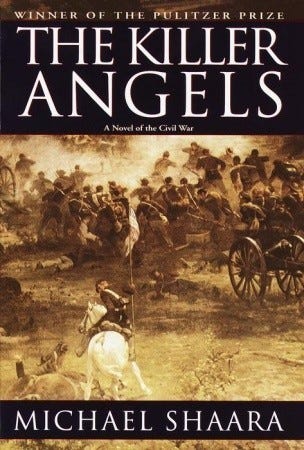The Killer Angels Revisited: Why This Civil War Novel Still Matters
More than a war story—this book captures leadership, decision-making, and the human cost of battle in ways that resonate even today.
"There’s nothing so much like a god on earth as a General on a battlefield."
This is a reposting of our review, first seen on 9 September 2024. At the time, we had only 143 subscribers. I’m sure that some of our subscribers who joined us after September have viewed this review in our archives; however, since several thousand new subscribers have joined us since then, we decided to repost it.
It’s a great story. I hope this review prompts you to read it (or reread it).
Key Insights from The Killer Angels
Historical Context: A historical fiction novel focused on the Battle of Gettysburg, bringing to life the experiences of key figures like Robert E. Lee, James Longstreet, and Joshua Chamberlain.
Leadership and Strategy: Highlights the critical decisions made by both Union and Confederate leaders, showing how strategy, terrain, and intelligence influenced the battle outcome.
Human Dimension: A portrayal of the internal conflicts, emotions, and bonds between soldiers, reminding readers that these historical figures were also human.
Battle Dynamics: Covers pivotal moments like Chamberlain’s bayonet charge and Pickett’s ill-fated assault, offering insight into military tactics and their consequences.
Timeless Lessons: This book reflects on the relevance of intelligence, decision-making under uncertainty, and the personal toll of leadership, which should resonate with both military professionals and general readers today.
For the Reader: Whether you’re a military professional, history enthusiast, or casual reader, this novel provides a gripping narrative with timeless leadership lessons, making it accessible and engaging for anyone interested in historical battles or decision-making under pressure.
The Killer Angels, first published in 1974, is a historical fiction novel about the Battle of Gettysburg fought in July 1863. It tells the story of the days leading up to the battle and the battle itself through the eyes of key combatants on both sides. The author, Michael Shaara, won a Pulitzer Prize for fiction in 1975 for his work on The Killer Angels.
I finished reading The Killer Angels for the second time a few weeks back. The first time was over 35 years ago when I was a young Marine Officer attending a career-level school in Quantico, Virginia. Like most Marine Corps Schools, there is an emphasis on the importance of reading for professional development. I was already an avid reader but had not read much about the Civil War. At the time, our focus was to understand and learn lessons from the battle: the importance of recognizing key terrain, what the commanders saw, what they knew (and did not know about the enemy and terrain), the decisions they made, and how they maneuvered their infantry brigades, divisions, and Corps supported by artillery and cavalry. And the cost of these decisions.
Keep reading with a 7-day free trial
Subscribe to The Military Reading Room - History, Strategy, and Insight to keep reading this post and get 7 days of free access to the full post archives.





